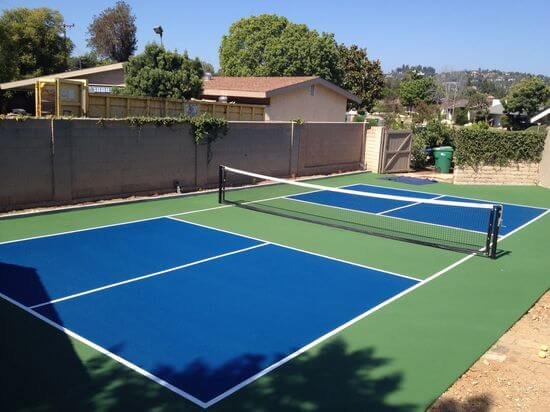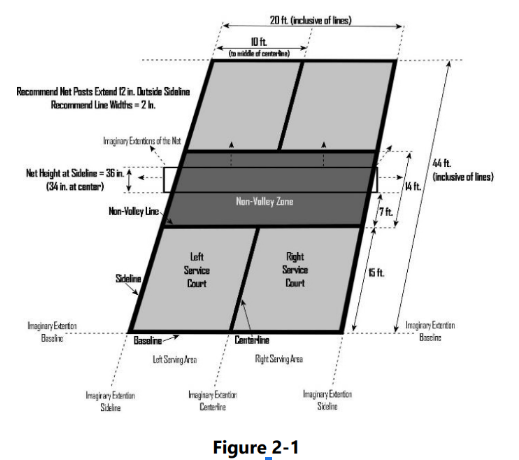Pickleball Court Dimensions and Requirements: Everything You Need to Know
A guide to Pickleball courts, including full dimensions, requirements and equipment
The popularity of the sport Pickleball has grown significantly in the last couple of years. Choosing a convenient court is one of the key elements of the Pickleball game.
In this article, we will take a closer look at the dimensions, requirements and everything you need to know about the Pickleball court!
Building your Pickleball court
Regardless of whether you’re wanting to build a Pickleball court in your home, recreation centre, community or country club, there are several things you need to know about the court and the right way to construct it.
The Material
For a Pickleball court, it is important that you select a suitably hard surface, free of bumps and holes.
We also recommend that you avoid grass and clay as these materials won’t allow the ball to bounce as much, or even at all.
Bear in mind that the balls used for Pickleball, unlike tennis balls, are made of perforated plastic and they don’t bounce very high on these surfaces.
If you’re looking for common surface materials for a Pickleball court, look into:
Asphalt – affordable and practical, but will require additional maintenance
Concrete – the best in terms of durability and value, concrete is usually the preferred material for a Pickleball playing surface
Snap-together plastic – these are special snap-together surfaces that are applied over concrete or asphalt in order to create a Pickleball court without permanently altering the surface of a multi-use court.
Required dimensions for the Pickleball playing area
The minimum space required: 30 x 60 feet – 9.14 m x 18.29 m
The preferred size: 34 x 64 feet – 10.4 m x 19.5 m
The USA Pickleball Rulebook further recommends the dimensions for the playing surface are as below.
The Pickleball court
Required dimensions for both singles and doubles play: 20 x 44 feet – 6.10 x 13.41 m
The court lines: the standard Pickleball court includes several lines. These lines are:
Baselines – these are lines that are parallel to the net and are placed at each end of the court
Sidelines – these are the lines that are perpendicular to the net on each side of the court
Non-volley zone – on either side of the net, there is an area of the court that is specific to each team and is bounded by a line between the two sidelines (non-volley zone line). This is 7 feet (2.13 m) from the net. It is important to mention that all the lines of the non-volley zone are part of the non-volley zone.
Service court – this is the area beyond the non-volley zone on either side of the centreline, including the centreline, sideline and baseline
Centreline – the centreline is a line that goes down the centre of the court on either side of the net. The centreline extends from the non-volley zone to the baseline, separating the odd and even courts.
Right/even court – this is considered the service area that is on the right side of the court when facing the net.
Left/odd court – this is considered the service area that is on the left side of the court when facing the net.
These court lines need to be painted in the same colour, contrasting with the colour of the overall playing area. This is 2” thick (5.08 cm).
The Pickleball net
The height of the net: at least 30 inches (0.76 m) from the bottom of the net to its top. More so, the net is usually 36 inches high at each sideline, and that number reduces to 34 inches in the middle
The length of the net: 21 feet 9 inches (6.63m) between posts
The material: this can be any mesh fabric that prevents the ball from going through it. The top of the net also needs to be edged with a 2 inch (5.08 cm) white tape; binding over a cord or cable running through the binding that rests upon the cord or cable.
The net requires permanent posts to support it. These steel posts are set at 22 feet, 4 inches apart, each approximately 50 inches long, and they have an outside diameter of 2-3/8 inches. They are typically painted black or dark green. It is best to choose rust-resistant materials, as Pickleball courts are usually outside.
Pickleball equipment
The ball
There are 2 different designs for a Pickleball ball.
Although usually all approved balls are acceptable for indoor or outdoor play, typically the balls with larger holes are used for indoor play, while the balls with smaller holes are used for outdoor play.
Typically, these balls are made of durable material, in one colour, with a minimum of 26 to a maximum of 40 circular holes with specific spacing between them.
The balls also contain the supplier’s or manufacturer’s name or logo on them.
The paddle
According to the USA Pickleball Rulebook, “The combined length and width, including any edge guard and butt cap, shall not exceed 24 inches (60.96 cm).
“The paddle length cannot exceed 17 inches (43.18 cm).
“There is no restriction on paddle thickness. There is no restriction on paddle weight, and the paddle must be made of any material deemed safe and not prohibited by these rules.”
Furthermore, according to the USA Pickleball Rulebook, this is how the Pickleball field is supposed to look, with all its correct dimensions and elements implemented:
Important
if you’re planning on setting up your outdoor Pickleball court on an existing court surface that is oriented in a typical north/south direction, make sure that the court is not in that same direction.
If you do this, then one player will constantly have to face the sun directly in the morning or afternoon, which can become a safety hazard.









